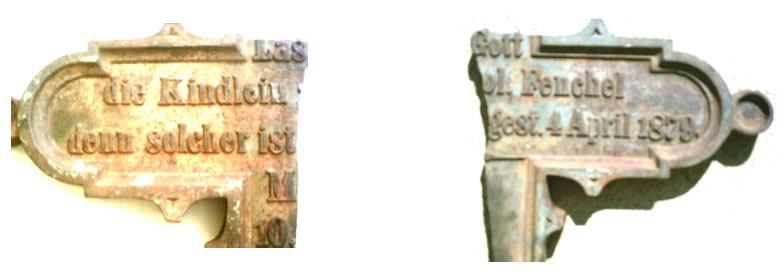Keetmanshoop - The Truth about the broken cross unearthed
Tuesday, 27th January 2015

By Jana-Mari Smith
The puzzle of a broken cross, and a desecrated grave, whose owner could not be identified until now, was solved this month during the accidental correspondence taken up by two complete strangers, whose only link is the southern town of Keetmanshoop.

Mr Willem Kotze, intent on preserving and highlighting Keetmanshoop’s history, and the great-grandson of a well-known historical missionary who lived in Keetmanshoop, Mr Walther Neuhaus, shed some light on the identity of the missionary’s eldest child, whose grave was vandalised by thieves last year.
In addition, a broken cross, which only shows the surname Fenchel, and the date of death, and half a bible passage, was handed to Kotze by a scrap metal dealer later that year, who found it amongst items that had been brought there.
Together, Kotze and Neuhaus realised that the cross, and the desecrated grave, was the last place of rest of the missionary, Pastor Tobias Fenchel’s, daughter, who died at birth.
Kotze discovered the name and contact details of a Mr Walther Neuhaus, this year, while researching the life of Pastor Tobias Fenchel. Kotze realised that Neuhaus is the greatgrandson of Fenchel, and made contact with him. Soon thereafter, they uncovered the truth of the cross, whose only markings was the surname Fenchel, and the date of death, 4 April, 1879.
Fenchel is well known to Namibian historians, and particular a source of pride people living in Keetmanshoop, as he built the second church of the town, which is still standing today.
Fenchel, who arrived in Keetmanshoop in 1876, went on to built a church, after the original church was flushed away after heavy rains on 26 October 1890.
In order to be able to teach his congregation, consisting mostly of the local Nama people, Fenchel also learnt the Nama language, which earned him much respect. He also began to translating Nama to Dutch, but his dictionary was only completed later by Rev. Georg Krönlein. Copies of the dictionary have not been located so far.
But, aside from his achievements as a public figure, Fenchel was also a family man. He and his wife, Anna Fenchel, had five children, but sadly, their eldest child, Marie, died shortly after her birth, on April 4, 1879. This year is the date of her 130st birthday.
The detailed story of Marie’s death was chronicled in a book, by her younger sister, Henriette Fenchel (later Becker), telling of the traumatic death of little Marie:
“When the couple received the gift a daughter in the year 1879, the child only lived for a short time.
The young mother in her isolation had looked forward to a child so eagerly, and then she had to surrender it so soon. A Baster woman assisted her in the darkest hours. With her she could speak Cape Dutch, which she had learnt a little of.
Because the young mother was very ill after the birth, she asked the woman to stay with her for the night. They had placed the little corpse into a chest of drawers, to be buried in the morning. The mother fell asleep in deep grief.
During the night, she awoke and thought that she had heard a faint whimper. She was frightened, because she was not sure if it had been dream or reality, and maybe the child was alive after all. But she was so weak that the Baster woman did not hear her call. In the morning, the Baster woman said “Imagine, during the night I thought that I heard the child crying, but then I realised that it is dead and I continued to sleep”.
That happening and the disappointment caused her (Mrs. Fenchel) deep grief for many years afterwards. For her, the little grave was a stronger tie to that godforsaken country, than any happy event could ever have been. “
(Translated from the German by Walther Neuhaus)
The story goes on to tell that the mother had to stay in bed for 19 weeks and was close to death several times.
This short translated passage from the book of Fenchel’s daughter, illustrates the importance that Marie’s grave held of the Fenchel family, in particular for Anna Fenchel.
Kotze described his anger towards the grave vandalisers, saying that aside from the historical value of the grave, they had also destroyed property which held, and still holds, great meaning for the descendents of Anna and Tobias Fenchel.
In his correspondence with Walther Neuhaus, Neuhaus expressed his relief at having uncovered the truth about the grave, and requested that Kotze keep the cross in safekeeping for the family.
“If you keep the cross for a family member to collect, we will be very, very grateful,” Neuhaus wrote to Kotze.
In their emails, Neuhaus also elucidated what the original bible passage, which was engraved on the back of the cross.
It is from Matthew 19:14 and reads:
"Let the little children come to me, and do not hinder them, for the kingdom of heaven belongs to such as these."